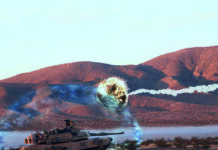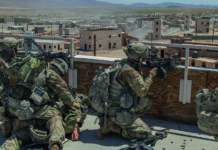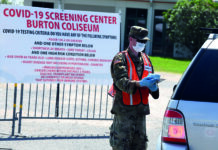Urban warfare is becoming increasingly visible on security, military, and political agendas, as modern war has been changing the battleground from the rural setting to the developing cities of the world, opening a complex set of new challenges, threats, and risks.
Today, approximately 55 per cent of the global population reside in urban centres with this number expected to rise by 2030 to over 60 per cent of the total population of 8.5Bn people living in an urban environment. Urbanisation has not only become an important key to development and evolution, but it has also provided a key strategic and symbolic domain for modern warfare. At present, more than 50 million people worldwide are affected by armed conflict in cities, and the numbers are still on the rise.
While acknowledging that urban warfare is not a new phenomenon, it is important to underline its complexity and continuous evolution which force militaries to systematically develop and adapt their training, tools, and capabilities. Unfolding in a multi-dimensional pattern, warfare in densely populated urban areas is an extremely hard form of warfare that implies challenging variables, such as a far-from-neutral environment, a complicated political and strategic context, and the extended need for in-depth training, specifically created for this task. Unfortunately, there are only a few modern militaries that have reached a certain level of experience in fighting in such an environment. The city presents the greatest challenge to any tactical force, when the task is to fight in it, instead of fighting for it. The cases of Mosul (Iraq), Tripoli (Libya), and Kabul (Afghanistan), together with technological developments, have underlined the need for better doctrine, training and equipment that can prepare us for the next war which will most probably be focused around the urban area. As Mark Milley, the US Chairman of the Joint Chiefs of Staff has warned before: “We need to train, man, and equip for that dense urban combat that’s very close, austere combat in urban terrain.”
The Urban Environment
Wolfel (2016) correctly identified the complexity of modern cities based on three fundamental concepts:
- multi-dimensional (subterranean, surface, and vertical)
- interconnected through globalisation, social media, and modern methods of communication
- uncontrollable due to inter connectivity, the rise of black markets, informal economies, and lack of government control over slums
Viewing the city as a living organism with its own metabolism, the urban environment can be assessed through three main elements: the terrain, the population, and the supporting infrastructure. Large cities are unique because they contain all three components of the urban triad in sufficient concentration to require one or more divisions to control. The vastness of the terrain, together with the number and density of the population and concrete structures, are just some of the critical basic data taken into consideration in the planning of military operations. But the size of urban areas and its main geographical and demographic characteristics, although extremely significant, should not be treated as the only variables. Rather, each urban context should be assessed through the lens of continuous change, rather than in static terms, just like a living, constantly evolving organism. Although not completely unpredictable, the urban environment can work to the disadvantage of troops that do not develop an in-depth understanding of its traits and dynamics.
The “Urban Warfare” Umbrella
The earliest forms of urban warfare primarily involved sieges, which can be traced back to antiquity, including in the Roman and Greek eras. Historical wars for example, fought in, and for Rome for ethnic, religious, political, and military reasons serve to highlight the symbolism of urban areas in warfare and the complexity of its space. But today, fighting in and around cities such as Beirut, Grozny, Sarajevo, Sadr City, Fallujah, Damascus, Helmand, Kabul, Mosul, and Tripoli, are replete with examples of extensive involvement of modern forces in cities. The instability and vulnerability of rapidly urbanised and developing cities makes the search for alternatives to full-scale urban warfare particularly urgent. This is especially true given the modest changes diagnosed in the recent conduct of urban warfare. Emerging frameworks of analysis and practice intended to prevent the occurrence of, or relapse into, armed conflict have not been consistently explored in the context of urban warfare, and the training in urban operations provided to most of the national militaries lacks key elements particular to the reality of the ground and local context. Moreover, there is a broad spectrum of operations under the general umbrella of urban warfare, such as policing operations, raids, and sustained urban combat, while the lines between these types of operations are rather blurred, making it hard to fully classify and differentiate. Still, certain characteristics can be observed in the global urban warfare trend.
The Strategic Level
At the strategic level, urban elements strongly influence the strategy of war. Urban operations have the potential to last longer than initially planned, increasing the costs, and even inflicting further collateral damage including civilian casualties and property destruction. The less concerned with the safety of the population at stake, the better chances to win the battle, but with heavy repercussions and long-term effects. Strategically, more than in any other type of operation, urban warfare implies an excellent understanding of the local context, the social-cultural-political dynamics of the region, the geographical space, and the population that might not be neutral in the battle. In this regard, warfare in an urban environment necessitates decentralised, small-unit operations at the tactical level, with junior leaders capable of operating independently using initiative, adaptability, and good judgment.
The Operational Level
At the operational level, urban warfare requires extended and specific training, doctrine, tactics, and equipment to cope with the environment, while it is very demanding in terms of resources and numbers of soldiers deployed on the ground. The complexity of these operations might result in increased pressure on the troops involved, while air power and bombing, together with close-air support, might bring strategic disadvantages rather than gains. Therefore, in preparation for any operational steps, urban warfare requires an understanding of the city at multiple levels, ranging from formal infrastructure and service provision to licit and illicit power-governance structures; flows of people, traffic and goods; and the pulse or rhythm of the city. All these levels demand a degree of understanding and appreciation that goes well beyond traditional aspects of military strategy and tactics.
The Tactical Level
At the tactical level, traditional military advantages can be outpaced by multiple weapon systems, and multi-domain characteristics facilitated by the urban environment. Therefore, units engaged in urban warfare should prepare and adapt for urban operations, combined arms warfare, developing HUMINT capabilities and equipping beyond MTOE authorisations, and reducing soldier load to increase mobility and agility. Indeed, the most effective way to gain ground in the urban environment is with specialist combined arms teams:
- mechanised
- infantry
- armour
- artillery
- comms and EW specialists
- Air PAM
- medical
- engineers
Lessons Learned
To begin with, the liberation of Mosul in July 2017 by Iraqi and Coalition forces from Daesh control ended nine months of intense urban combat against a hybrid adversary who had almost three years to prepare for the battle.
Mosul
It was a decisive battle for the campaign against the former ISI – the Iraqi branch of Daesh and involved fast-paced operations – unpredictable in length, costly in resources, and devastating to the infrastructure, population, and character of the city. On the other side of the coin, the liberation of Mosul resulted in enormous collateral damage. More than 10,000 civilians were killed, including at least 2,300 killed by Coalition airstrikes and indirect fire (artillery and rockets). More than 44 per cent of Mosul’s population (800,000 civilians out of a total of 1.8 million) was displaced across Northern Iraq, while tens of thousands of private and public properties have been destroyed and valuable infrastructure damaged. The battle for Mosul represents a clear example of the difficulty of balancing the tactical focus demanded by high-intensity urban combat with broader strategic objectives, including protection of civilians. It took nine months for 90,000 Coalition troops to defeat about 5,000 Daesh fighters in an environment in which low-technology, brutal on-the-ground fighting, became the only viable option.
In the aftermath of the battle, several observations should be underlined to guide the operational approach for the next urban engagement. Firstly, the interconnectivity mentioned above has again proved that it is impossible to ‘isolate’ a modern city. Secondly, as the depth and duration of urban fighting intensifies, the difficulty faced by troops increases, inflicting further physical and psychological pressure on soldiers. Thirdly, when planning, it should be borne in mind that operational reach is proportional to population support – an element that is not easily granted or ensured. Fourthly, dense urban terrain highlights the importance of controlling critical infrastructure outside the core urban terrain (including water supply, sanitation, electrical power generation and distribution) within the city itself. Lastly, the importance of the delivery of non-lethal effects in dense human terrain and interconnected networking is crucial for preventing high rates of collateral damage.
Tripoli
The latest phase of Libya’s ongoing rounds of civil conflict, known as the War for Tripoli (April 2019-June 2020), ended abruptly after extensive Turkish military capabilities were introduced to the theatre beginning in January 2020. Based on the Tripoli experience of urban warfare, further lessons have been learned. To begin with, international norms and even UN Resolutions have proved inefficient in preventing the unbridled introduction of sophisticated weapon systems and operatives into previously low-intensity and low-tech civil wars. Secondly, in the context of open spaces of desert-like terrain, aerial supremacy can offer the decisive factor in contemporary low-intensity civil wars, but they are not sufficient on their own in the modern urban environment. Thirdly, mercenary ground troops are unlikely to win wars in both urban and rural situations where the local population’s support is weak. Furthermore, mercenary forces are likely to suffer from casualty-aversion and to outrage local populations by any of their excesses. Finally, due to external support, Tripoli was the first of a new kind of military conflict where various military capabilities have been possessed and deployed simultaneously based on critical ground assessments. The way in which drones and counter anti-aircraft capabilities have been strategically deployed is highly likely to be studied and possibly imitated in other theatres. Nonetheless, this battle has not marked the end of the Libyan struggle.
Kabul
After Mosul and Tripoli, 2021 brought another important lesson from Kabul. After 20 years of war and gigantic financial and human investment on the battlefield, the withdrawal from Afghanistan and the return of the Taliban has presented valuable lessons in terms of urban operations and our preparedness to the current dynamics of urban warfare. The country has experienced one of the fastest urbanisation waves in the world, driving migration from rural areas to the urban space. Still, while economic opportunities attracted the population, chronic droughts and floods were also significant reasons for Afghans to migrate to cities. The government and the international presence on the ground has failed to keep pace and develop the infrastructure necessary for the developing cities to strive and prosper. Soon, those urban areas have become the meeting point for various actors: the central government, the Taliban, strongmen and their militias, and criminal networks.
Although physically on the ground, foreign troops failed to provide a meaningful presence that would have allowed them to understand and tackle the developing dynamics at the right moment. Instead, because of overlapping factors and lack of objectivity, the Taliban’s territorial influence rapidly expanded, bringing the insurgency to the doorstep of major cities across the country — even to the capital of Kabul. The Taliban easily adapted to the conditions of waging war inside urban areas, marking a clear and obvious shift in their strategy. In nine months, they perpetrated attacks aimed at eliminating potential sources of opposition to their rule, such as civil society activists and journalists. Bearing in mind that urban operations are both resource and soldier-intensive, commanders must plan adequate quantities and the right types of forces to conduct successful urban operations, based on a feasible assessment of the dynamics on the ground. Therefore, enabling efforts such as information operations and intelligence gathering are often more than just supporting roles but are instead vital to the success of urban operations.
Outlook
Urban warfare is an evolving phenomenon that demands better preparation and adaptability capabilities from military forces around the globe to fight a number of developing threats. While battles in urban environments around various regions of the globe have increased our knowledge and experience, future threats and technologies will also significantly impact the urban environment and how forces will operate there, thereby impacting the protection of civilians. Bearing in mind that many life-sustaining functions of urban areas are becoming data-dependent, while connected urban systems also generate essential data, the physical well-being of civilians in a contested urban environment will be heavily affected by combatants’ information operations.
Nevertheless, the symbolic, strategic, political, and economic value of the cities continue to attract state and non-state adversaries, providing them the opportunity to hide amongst the population and weaponise networks, institutions, and resources for military purposes. Moreover, as increasing connectivity has helped the evolution of our urban environment, it also has the capacity to provide adversaries with the perfect tool to disrupt or control larger urban areas with smaller forces, or to control them by interdiction from outside without needing to occupy or directly attack them. With the current fast technological advances, future wars will not only be happening in the urban realm, but in a “smart city” that requires a completely different set of capabilities, tools, and assets to tackle the new threats. Urban operations of the future will demand the human and technological capacities to prevent weaponisation of city technology from targeting populations or critical systems. Also, to protect smart infrastructure and navigational systems against disruption, to counter risks arising from unprecedented information collection and access opportunities, allowing armed actors to identify, target, or influence civilian populations through manipulation of information, and ensure a broader dispersal of critical infrastructure in case of an attack.











